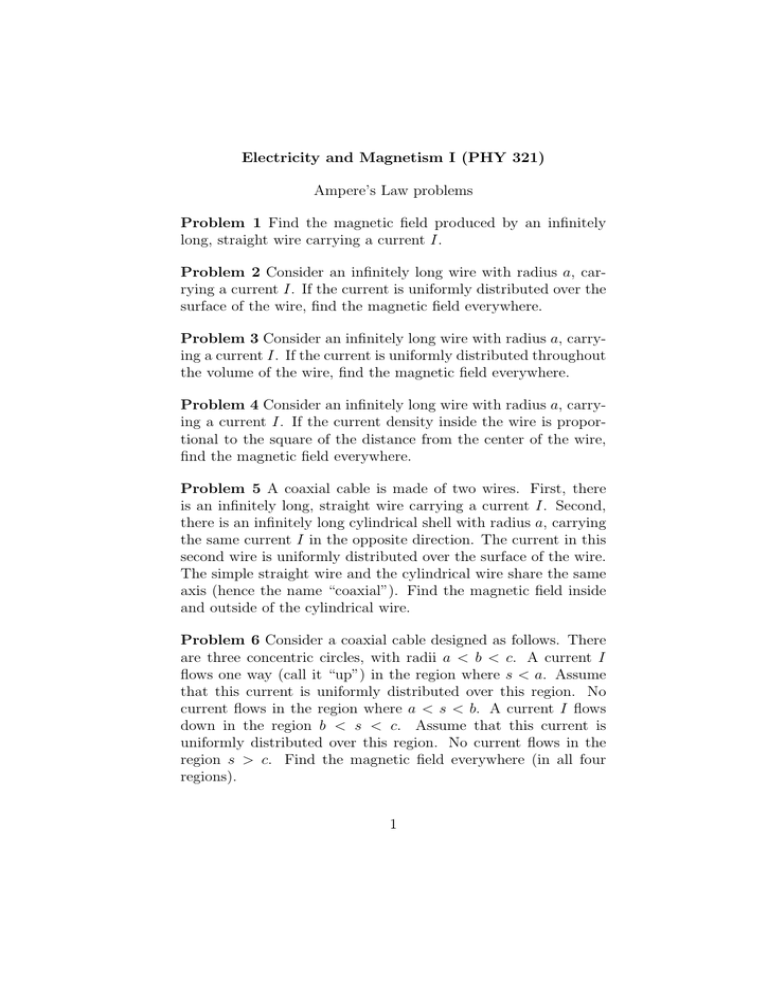Electricity and Magnetism I (PHY 321) Ampere`s Law problems
advertisement

Electricity and Magnetism I (PHY 321) Ampere’s Law problems Problem 1 Find the magnetic field produced by an infinitely long, straight wire carrying a current I. Problem 2 Consider an infinitely long wire with radius a, carrying a current I. If the current is uniformly distributed over the surface of the wire, find the magnetic field everywhere. Problem 3 Consider an infinitely long wire with radius a, carrying a current I. If the current is uniformly distributed throughout the volume of the wire, find the magnetic field everywhere. Problem 4 Consider an infinitely long wire with radius a, carrying a current I. If the current density inside the wire is proportional to the square of the distance from the center of the wire, find the magnetic field everywhere. Problem 5 A coaxial cable is made of two wires. First, there is an infinitely long, straight wire carrying a current I. Second, there is an infinitely long cylindrical shell with radius a, carrying the same current I in the opposite direction. The current in this second wire is uniformly distributed over the surface of the wire. The simple straight wire and the cylindrical wire share the same axis (hence the name “coaxial”). Find the magnetic field inside and outside of the cylindrical wire. Problem 6 Consider a coaxial cable designed as follows. There are three concentric circles, with radii a < b < c. A current I flows one way (call it “up”) in the region where s < a. Assume that this current is uniformly distributed over this region. No current flows in the region where a < s < b. A current I flows down in the region b < s < c. Assume that this current is uniformly distributed over this region. No current flows in the region s > c. Find the magnetic field everywhere (in all four regions). 1 Problem 7 Consider a coaxial cable designed as follows. A current I flows down a long straight cylidrical wire as a uniform surface current at s = a. The same current flows in the opposite direction as a uniform surface current at s = b. Take a < b and make a picture of this situation with a clearly-defined coordinate system. Find the magnetic field everywhere. Problem 8 Consider an infinite plane with uniform surface current density K. Choose a coordinate system and find the magnetic field everywhere. Problem 9 Consider two infinite planes, parallel to each other and spaced a distance a apart. Suppose they both carry the same uniform surface current density K in the same direction. Choose a coordinate system and find the magnetic field everywhere. Problem 10 Consider two infinite planes, parallel to each other and spaced a distance a apart. Suppose they carry the same uniform surface current density K, but in opposite directions. Choose a coordinate system and find the magnetic field everywhere. Problem 11 Consider an infinite planar slab, with thickness d. It carries a uniform current density J parallel to the slab. Choose a coordinate system and find the magnetic field everywhere. Problem 12 Consider an infinite planar slab, with thickness d. The lower surface of the slab is on the plane z = −d/2. The upper surface of the slab is on the plane z = d/2. The current density inside the slab is J = βz 2 x̂, where β is a constant with appropriate units. Find the magnetic field everywhere. Problem 13 Consider an infinitely long solenoid with radius R and n turns per unit length carrying a current I. Find the magnetic field inside. Problem 14 Consider two concentric infinitely long solenoids with radii R1 and R2 (R1 < R2 ). The inner solenoid has n1 turns per unit length. The outer solenoid has n2 turns per unit length. 2 The wire around the inner solenoid carries a current I1 (counterclockwise, let’s say), and the outer solenoid carries a current I2 in the same direction. Find the magnetic field everywhere. Problem 15 Consider an infinitely long solenoid that has so much wire wrapped around it that it has become “fat”. The wire on the inside is a distance a from the central axis and the wire on the outside is a distance b from the central axis (a < b). We model this with a current density J = J φ̂ in the region a < s < b. Outside of this region, there is no current. Find the magnetic field everywhere (there are three regions). Problem 16 Consider a cylinder with radius R, infinitely long. A uniform charge density ρ is distributed throughout the volume of the cylinder. Take the z axis of your coordinate system to be along the axis of the cylinder. If this cylinder rotates about its axis with angular velocity ω, find the magnetic field produced at an arbitrary point in space, inside or outside of the cylinder. Problem 17 Consider a toroid (a donut wound with wire carrying current I) with inner radius a and outer radius b. Find the magnetic field inside the toroid. 3





